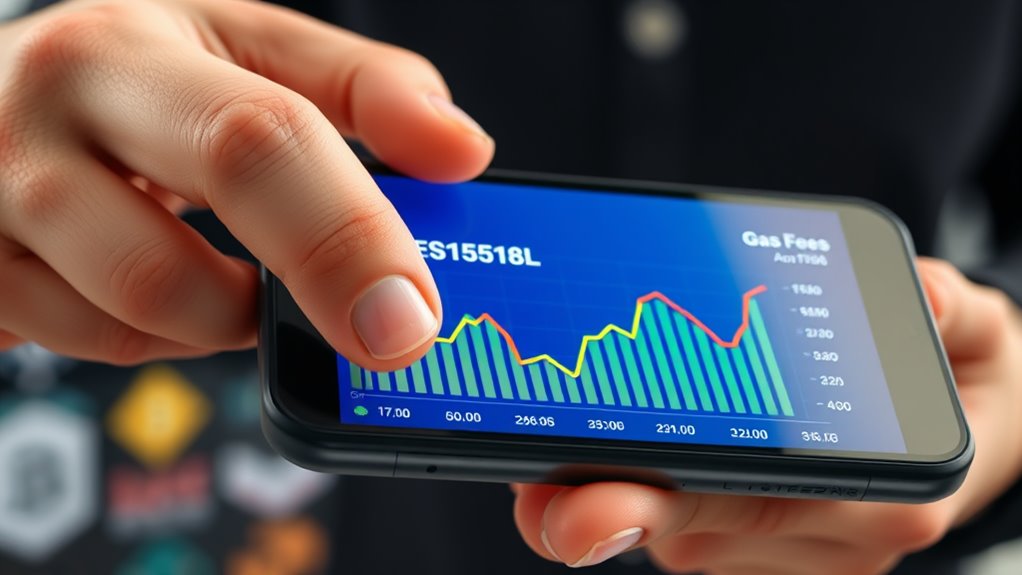
Gas Fees and Transaction Costs Explained: How to Minimize Them
Gas fees are costs incurred during transactions on blockchain networks, primarily impacting affordability. They consist of a base and priority fee, influenced by network demand and transaction complexity. Heavily congested periods raise these costs considerably. To minimize gas fees, users can conduct transactions during off-peak hours, simplify smart contracts, batch transactions, or use estimation tools to determine ideal prices. Exploring Layer 2 solutions can also enhance efficiency. Learning more about these strategies can further aid in cost management.
Key Takeaways
- Gas fees fluctuate based on network congestion, so conduct transactions during off-peak hours to minimize costs.
- Simplify smart contracts to reduce complexity and lower gas fees associated with transaction processing.
- Batch multiple transactions together to consolidate fees and decrease overall transaction costs.
- Use gas fee estimation tools to determine ideal prices and avoid overpaying for transactions.
- Explore Layer 2 solutions for lower fees and improved transaction efficiency on blockchain networks.
Understanding Gas Fees: What Are They and Why Do They Matter?

Gas fees represent a fundamental aspect of blockchain technology, particularly on networks like Ethereum, where they serve as the costs users incur for conducting transactions.
These fees play a vital role by incentivizing validators to process transactions efficiently and honestly. Comparable to fuel costs for vehicles, gas fees guarantee users pay for network usage.
Gas fees incentivize validators to ensure efficient and honest transaction processing, much like fuel costs for vehicles.
Typically denominated in the blockchain’s native currency, such as Ether for Ethereum, these fees fluctuate based on network congestion, impacting transaction times and costs.
Additionally, gas fees help prevent spam transactions by imposing a cost on all network activities.
How Gas Fees Are Calculated: The Mechanics Behind Transaction Costs

Understanding the calculation of transaction costs is essential for anyone engaging with blockchain technology.
Gas fees are primarily determined by several factors that influence their price and structure:
- Gas Fee Components: Comprising a base fee and a priority fee, these two elements collectively determine the total cost.
- Network Demand: Fees fluctuate based on congestion, where increased demand raises costs.
- Gas Limit: Users set a maximum gas allowance for transactions, which can affect both complexity and price.
- Real-Time Adjustments: The Ethereum network employs dynamic pricing through EIP-1559, allowing fees to adjust based on current network conditions.
Ultimately, understanding these mechanics helps users make informed decisions regarding their transactions and associated costs.
Comparing Gas Fees Across Blockchains: Which Ones Are the Most Cost-Effective?

Which blockchain offers the most cost-effective gas fees for users?
In the blockchain landscape, several options stand out for their lower transaction costs. Ethereum is known for its high gas fees, especially during busy periods.
In contrast, Binance Smart Chain (BSC) provides a more affordable alternative, making it attractive for decentralized finance (DeFi) projects.
Polygon, a Layer 2 solution, considerably reduces fees compared to Ethereum, ideal for frequent transactions.
Solana also boasts low fees and rapid transaction speeds, suitable for high-volume applications.
Finally, Algorand charges dynamic fees, typically at a fraction of a cent, ensuring affordability.
As cryptocurrency transactions evolve, the integration of blockchain and AI is expected to enhance the efficiency and security of payment processes.
Users seeking cost-effective solutions may find these blockchains advantageous for their needs.
Factors Influencing Gas Fees: What Drives Their Fluctuation?

What factors contribute to the fluctuations in gas fees on blockchain networks? Several key elements influence the costs associated with transactions.
- Network Congestion: High demand for transaction processing can lead to increased fees as users compete for block space.
- Transaction Complexity: More intricate transactions require additional computational resources, resulting in higher gas fees.
- Time of Day: Gas fees may vary based on the time transactions are made, often being lower during late-night or early-morning hours.
- Market Events: Significant market movements or changes in sentiment can cause sudden spikes in gas fees as users rush to execute their transactions.
Understanding these factors can help users anticipate and navigate gas fee fluctuations effectively.
Strategies for Minimizing Gas Fees: Tips for Cost-Effective Transactions

Minimizing gas fees is vital for users looking to make cost-effective transactions on blockchain networks. One effective strategy is to enhance smart contracts by simplifying their logic, using libraries, and testing for bottlenecks.
Efficient transaction planning also plays an important role; conducting transactions during off-peak hours can help lower fees, as can batching multiple transactions into one. Users should utilize gas fee estimation tools to set ideal prices.
Efficient transaction planning, like timing and batching, can significantly reduce gas fees. Utilize estimation tools for optimal pricing.
Additionally, exploring Layer 2 solutions like Optimism or Arbitrum can greatly reduce costs. Implementing transaction compression techniques, such as data compression and off-chain order matching, further enhances efficiency.
Finally, employing automated tools for monitoring and analysis can help users adjust their strategies in real time, ensuring ongoing cost-effectiveness.
Frequently Asked Questions
Can Gas Fees Be Refunded if a Transaction Fails?
Gas fees cannot be refunded if a transaction fails, as the blockchain’s design requires validators to be compensated for their computational efforts regardless of the transaction’s outcome, ensuring operational efficiency within the decentralized network.
How Do Gas Fees Affect Transaction Speed?
In the bustling marketplace of digital transactions, gas fees directly impact transaction speed. Higher fees expedite processing, especially during network congestion, while lower fees may lead to delays, reflecting the competitive nature of blockchain operations.
Do Wallet Providers Charge Additional Fees on Top of Gas Fees?
Wallet providers may charge additional fees for services such as fiat conversions, enhanced security, or premium features. These fees are separate from gas fees, which are determined by the Ethereum network based on transaction complexity.
Are Gas Fees Standardized Across Different Wallets?
Gas fees are not standardized across different wallets. Variations arise from each wallet’s unique settings, gas price options, and the specific blockchain’s fee structure, resulting in differing costs and presentation methods for users.
How Can I Predict Future Gas Fee Trends?
To predict future gas fee trends, one might analyze Ethereum’s shift to Proof of Stake, observing how this upgrade potentially stabilizes fees. Monitoring tools and market dynamics also provide insights into upcoming fluctuations and demand surges.
Conclusion
In summary, understanding gas fees and transaction costs is essential for anyone engaging with blockchain technology. Like traversing a busy highway, knowing how to avoid traffic can save time and money. By becoming familiar with the factors that influence these fees and employing effective strategies to minimize them, users can greatly reduce their costs. With this knowledge, individuals can make informed decisions, ensuring that their transactions are not only efficient but also economically sound.












